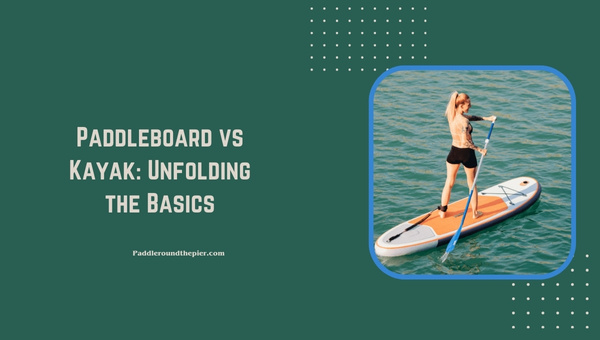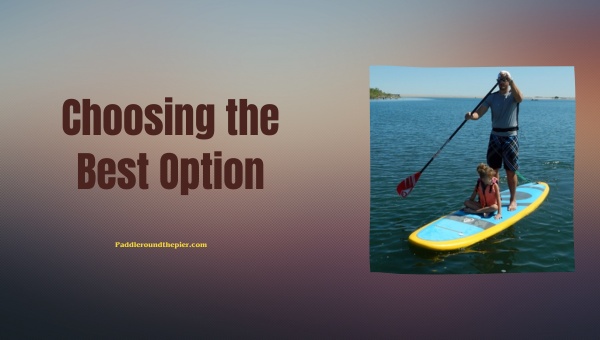Paddleboard vs Kayak: Spotting Differences
Every water sport aficionado grapples with the decision - paddleboard vs kayak? It's a classic showdown between these two incredible aquatic sports, and if you're caught in that debate, this blog post will be your compass.
In this dynamic realm of water sports, everyone has their champion. For some, paddling on a serene lake atop a paddleboard is the penultimate leisure activity, while others prefer to slice through waves with enthusiasm in a robust kayak. Yet the question remains - should I paddle board or should I kayak? Well, let's get into it!
So What Will You Discover Here?
- In-depth understanding of what a paddle board and kayak are
- Key differences between paddleboarding and kayaking
- Factors to consider for your next aquatic adventure
- A comprehensive guide on when to choose which based on different circumstances
Paddleboard vs Kayak: Unfolding the Basics
When deciding on the great debate of paddleboarding or kayaking, it's essential to start from the foundations and understand what each option entails.

What is a Paddleboard?
Paddleboarding provides a unique perspective on water sports. Standing upright on a large surf-like board, you use a long paddle to propel yourself across serene bodies of water. If you've ever dreamed of walking on water - paddleboarding is probably as close as you'll get!
Let's break down some distinct characteristics:
- Balance-Heavy: Learning how to balance correctly will take some practice, but once you've got it down, there's nothing quite like gliding effortlessly across the surface.
- Versatile: It can be done on any body of water – tranquil lakes, rushing rivers, or even out in the open ocean.
- Workout: It offers an excellent full-body activity focusing primarily on core strength and upper-body muscles.
By stepping onto a paddleboard, prepare for an immersive experience where it’s just you and Mother Nature engaging in peaceful harmony. Over time and with practice, this trait gets amplified when exploring paddleboarding vs kayaking.
What is a Kayak?
Kayaking trades off that immersion for speed and smooth handling. Splitting my time between paddling experiences allows me to compare both options fairly. Rest assured that if rate what you're after alongside a lower center of gravity, then kayaking might be more your speed (pun intended).
What makes kayaks stand out:
- Seated Position: This low-to-the-water seated position renders stability – perfect even if harsh conditions prevail.
- Glide Factor: With streamlined builds tailored for efficient movements through water bodies, covering more considerable distances becomes easier.
- Gear Friendly: The design comfortably accommodates gear such as fishing equipment or camping supplies - a keystone difference when comparing paddleboard vs kayak.
Also Read: Winter Kayaking: Your Ultimate Guide To Master the Chill
Key Differences Between a Paddle Board and Kayak
A paddle board is a larger, stable board that is used for standing and gliding on water, while a kayak is a smaller, enclosed boat that is used for sitting and paddling in water. Additionally, paddle boards are more suited for leisurely activities and yoga, while kayaks are designed for faster, more adventurous water exploration.
Design Traits
When exploring ‘paddleboard vs kayak’ design traits, we unveil significant differences:
- Shape & structure: Paddle boards are typically long, flat, and less hydrodynamic than kayaks which conversely have distinct hulls with pointed protrusions both front and back.
- Stability: The flat wide structure of paddle boards inherently provides greater stability when still besides providing an elevated viewpoint compared to sitting within the confines of a kayak.
- Maneuverability: Although both can be maneuvered rather smoothly, I find that kayaks move more swiftly & noiselessly through the water due to their streamlined shape.
Gear Involved
Equipment needs for paddle boards and kayaks do vary:
- Paddle Boards: A single-bladed paddle is typically used. Additional gear like a personal flotation device (PFD), leash, and optional accessories like yoga mats or luggage nets can be added.
- Kayaks: Kayaking requires double-bladed oars along with a PFD. Additional safety gears like a bilge pump and first aid kit are also common accompaniments.
Ease of Use
To me, both paddleboarding and kayaking have their learnings:
- Paddleboards: They require good balance to get standing upright besides needing your core strength for paddling - but once mastered, they can be highly enjoyable even in a wide range of water conditions.
- Kayaks: Learning to kayak may feel initially less daunting as you stay seated & stable within your vessel. Nonetheless, understanding forward stroke and learning how to navigate currents takes practice.
Therefore, assessing ease of use ultimately revolves around individual stamina, balance skills, and, most importantly, interest! So before choosing between 'paddleboard or kayak’ consider how comfortable you are with open waters, standing vs sitting positions, or balancing while paddling!
Also Read: Unlocking the Top 10 Kayaking Rules for Safe, Fun Adventures
Considering Your Adventure Needs
Choosing between a paddleboard and a kayak isn't only about the differences in design, gear, or ease of use; it's also about aligning your adventure needs with the right choice. Some people thrill at using body balance as they paddle through waves; others prefer sitting comfortably while they propel through water bodies.

To make this choice less confusing for you, I'll break down the fitness and health considerations, fishing opportunities, and scenery enjoyment potentials for both adventures.
Fitness and Health Considerations
Paddleboarding offers an intense full-body workout that caters to various fitness levels:
- Core Strength: Balancing on a paddle board requires isometric contractions from your core muscles.
- Balance Training: Training your balance not only improves coordination but also posture.
- Whole Body Workout: From paddling to balancing – nearly all muscle groups are activated in stand-up paddleboarding.
On the other hand, kayaking provides its unique physical benefits as well:
- Upper Body Workout: Paddling a kayak primarily works out your upper body muscles.
- Cardiovascular Fitness: Long-duration kayaking can be an excellent way to improve cardiovascular health.
Overall, deciding whether to choose paddleboarding vs kayaking will depend on what type of workout you seek.
Fishing Opportunities
Paddleboard or kayak? The answer might be clearer if you're an angler:
- Kayaks are arguably better suited for fishing activities due to their stability and storage space. They often come equipped with rod holders and compartments for bait and catch.
However, don't think that fishing on a stand-up paddleboard is impossible! Some boards are specially designed for anglers, incorporating places where equipment can be tied down as long as you have good balance skills!
Enjoying Sceneries
While there's no definite winner in enjoying sceneries when it comes to choosing between a paddleboard and a kayak, each provides unique opportunities:
- Paddle Boards: Stand-up paddlers have a broader viewing radius due to their high vantage point. This allows them to sightsee over long distances and look deep into clear waters.
- Kayaks: Kayaking allows for accessibility into tight waterways where paddle boards might not fit. This makes it possible to explore hidden, scenic pockets around coastlines.
Remember, whatever you choose between paddleboarding vs kayaking, the real joy is in the journey itself rather than the destination! Choose what you feel closely aligns with your adventure preferences and dive in!
Also Read: The Ultimate Guide to Paddle Board Transport: Do it Right!
Choosing the Best Option
I've been through the journey of deciding between a paddleboard vs kayak. That's what makes me eager to give you honest advice on making your choice when it comes to picking an outdoor adventure activity.
When to Choose a Paddle Board?
If you are into these scenarios and situations, then look no further than a paddleboard:
- If balance is your game, then this could be your call. Paddleboarding will test your balance while providing an intense workout.
- Are you looking for some 'me time'? Paddleboarding offers 'peace and calmness'. While navigating on one, I often feel like I am walking on water.
- Want impressive Instagram pictures? Being upright on a paddleboard gives an unmatched perspective for nature photographs.
- For all cardio enthusiasts out there, hopping onto a paddleboard can offer great core workouts.
Now that we have established when a paddleboard should be your pick, let's delve into the arena where kayaking takes home the gold.
When to Choose a Kayak?
A kayak might be an ideal choice in this selection of scenarios:
- Are you fond of long-distance trips or camping excursions? Great! Kayaks sport ample storage space, perfect for those multi-day paddling adventures.
- Do you enjoy speed and power-driven experiences over casual drifting? Then, kayaking can offer swift movements by harnessing currents and waves.
- Are you planning any aquatic outings in harsher weather conditions or rough waters? A kayak’s stability, ease of maneuverability, plus protective deck cover often make them preferable in such situations.
- The keen angler who loves freshwater or saltwater fishing? Kayaks have specialized features designed with fishing activities in mind.
The decision lies solely dependent upon personal preference. Based upon which facets pull more weight to your interests, paddling preferences are either leisurely experience or calorie-burning workout, picturesque sceneries versus fishing adventures, balance training, or speed thrilling.
Bear in mind that there's no surefire choice in the paddleboard vs kayak debate, only what details align best with the challenging and adventurous outdoor water encounter you're aiming for. So choose wisely and trust your gut instincts!
FAQs
Is stand-up paddle boarding harder than kayaking?
In terms of beginner-friendly recreation, both have their learning curves. Kayaking might feel easier to begin with due to its more stable nature, but mastering a stand-up paddleboard can also be quite straightforward with some practice.
Which one is safer: A paddle board or kayak?
Safety largely depends on your skills and how you use the equipment. Both can be safe in calm waters, but a kayak might offer more stability in choppy water due to its closed design.
Can you fish from both a paddleboard and a kayak?
Absolutely! Both paddle boards and kayaks provide suitable platforms for fishing. However, your preference might depend on factors like stability, storage space, and mobility on water.
Conclusion
As I wrap up this adventurous journey through the contrasts and comparisons of paddleboarding vs kayaking, it's fair to say that both have their unique benefits and attractions. Your selection between a paddleboard or kayak ultimately depends on what kind of water excursion suits your style, fitness levels, and soaking scenery preferences.
It can also hinge on whether you enjoy the gentle rhythm of paddling standing up or prefer using dual-sided oars while seated. For fishing enthusiasts, a calm kayak experience might be just the thing. But if it’s an all-in-one workout you’re after, then let paddleboarding usher you into the realm of fitness with style.
Key Takeaway Points
- Paddleboards provide an overall body workout, while kayaks focus more on the upper body.
- Kayaks are more suitable for long trips and harsh weather conditions.
- Paddleboards offer better views and serenity.
